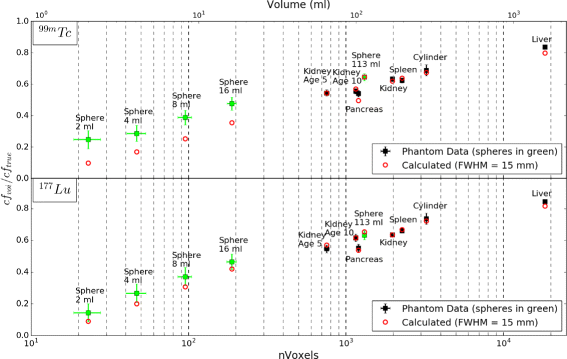UK Researchers Create 3D Printed Phantom Inserts for More Accurate, Customized Dosage in Molecular Radiotherapy
Molecular radiotherapy is a crucial part of treatment for many patients suffering from cancer and other conditions, generally with the goal being to send radiation to tissue exhibiting malignancy. MRT is still an evolving discipline, but one that is growing quickly. And now, researchers are using 3D printing to further the progress of this type of treatment.
Just published in EJNMMI Physics, authors Andrew P. Robinson, Jill Tipping, David M. Cullen, David Hamilton, Richard Brown, Alex Flynn, Christopher Oldfield, Emma Page, Emlyn Price, Andrew Smith, and Richard Snee outline their findings in ‘Organ-specific SPECT activity calibration using 3D printed phantoms for molecular radiotherapy dosimetry.’
As 3D printing has made huge strides within the medical field already, looking toward a future of patient-specific treatment, researchers are examining how this can be applied on many levels. In this context, the scientists from the Schuster Laboratory at the School of Physics and Astronomy at The University of Manchester were concerned with customized, absorbed dose calculations for molecular radiotherapy, and how to achieve the most accurate activity quantification. The traditional process relies on Single-Photon Emission Computed Tomography (SPECT) imaging. With SPECT, counts are detected regarding activity in phantom inserts, Camera-specific calibrations are often relied on as well due to the intrinsic and ‘many quantitative inaccuracies’ found in SPECT imaging.
“Calibration factors determined from physical phantom data are highly dependent on the specific geometry and activity distribution being considered,” state the researchers in their paper. “The geometry of phantom inserts used for SPECT activity calibration is often far removed from both the clinical situation and the mathematical models which provide the basis of the most common MRT dosimetry calculations.”
According to the researchers, who point out that the MIRD schema (created so that medical professionals could calculate mean absorbed dose from distributed sources of radioactivity) is the only FDA-approved general MRT dosimetry code, with access to phantoms allowing for more ‘approximate clinical MRT distributions,’ there is great potential for accurate patient-dosimetry that should be available to any center offering the radiotherapy. This means that dosages would be calculated in regards to the patient’s age, sex, and with consideration to their individual organ masses.
With 3D printing, the researchers were able to make the phantoms inserts on a Stratasys Dimension Elite 3D printer. Made with 2mm thick walls, or 3mm for the liver model as it is larger, the researchers fill the inserts with a radioisotope solution.
The team made inserts for all ages, from that of liver models for adults to inserts that would be appropriate for kidneys in those from ages five to ten. In the adult model, they were able to add to extra lobes as well as a 16 ml tumor (see Figure One).
In testing, the researchers found the phantom inserts, printed in ABS, to be very effective, with calibration factors showing a 24%, 11% and 8% reduction in absorbed dose for the liver, spleen, and kidneys, respectively. Stating the results were reproduced accurately with Gaussian kernel based calculations over two orders of magnitude change, the researchers had a very positive conclusion.
“These results highlight the potential for individualized whole organ activity quantification, corresponding to patient organ VOIs [volumes of interest], to improve accuracy in whole organ dosimetry,” stated the researchers.
“The ability for clinical centres to test SPECT systems with activity distributions which represent the mathematical models underlying MIRD schema dose calculations is a crucial step in establishing validated MRT dosimetry.”
They point out that these inserts should be easily accessible for medical centers even without their own printer, as they can send them out to a local service bureau for fabrication. With the ability to produce these customized inserts on their own—whether using their own machine printing in ABS or another—the researchers are hopeful that clinical centers everywhere should be able to make these as routine practice eventually. As the phantoms help provide better calibration, more accurate dosages can be maintained overall. Do you know anyone undergoing MRT? Let’s discuss this topic further over in the 3D Printed Phantom Inserts forum at 3DPB.com.
[Source: 7th Space Interactive]
Figure Two. From the researcher’s paper: Ratio of VOI calibration factor (cf voi ) to true camera sensitivity calibration factor (cf true ), as a function of number of voxels in VOI (nVoxels). Data is shown for phantom measurements (blackand green squares) and corresponding calculated values (red circles) (Eq. 7). The plotted standard uncertainties include a ±1 voxel (4.42 mm) uncertainty in positioning the VOIs.
Subscribe to Our Email Newsletter
Stay up-to-date on all the latest news from the 3D printing industry and receive information and offers from third party vendors.
Print Services
Upload your 3D Models and get them printed quickly and efficiently.
You May Also Like
3D Printing News Briefs, July 2, 2025: Copper Alloys, Defense Manufacturing, & More
We’re starting off with metals in today’s 3D Printing News Briefs, as Farsoon has unveiled a large-scale AM solution for copper alloys, and Meltio used its wire-laser metal solution to...
3DPOD 260: John Hart on VulcanForms, MIT, Desktop Metal and More
John Hart is a Professor at MIT; he´s also the director of the Laboratory for Manufacturing and Productivity as well as the director of the Center for Advanced Production Technologies....
3D Printing News Briefs, June 28, 2025: Defense Accelerator, Surgical Models, & More
In this weekend’s 3D Printing News Briefs, 3YOURMIND was selected to join an EU Defense Accelerator, and PTC has announced model-based definition (MBD) capabilities within Onshape. Finally, a study out...
EOS in India: AM’s Rising Star
EOS is doubling down on India. With a growing base of aerospace startups, new government policies, and a massive engineering workforce, India is quickly becoming one of the most important...



































